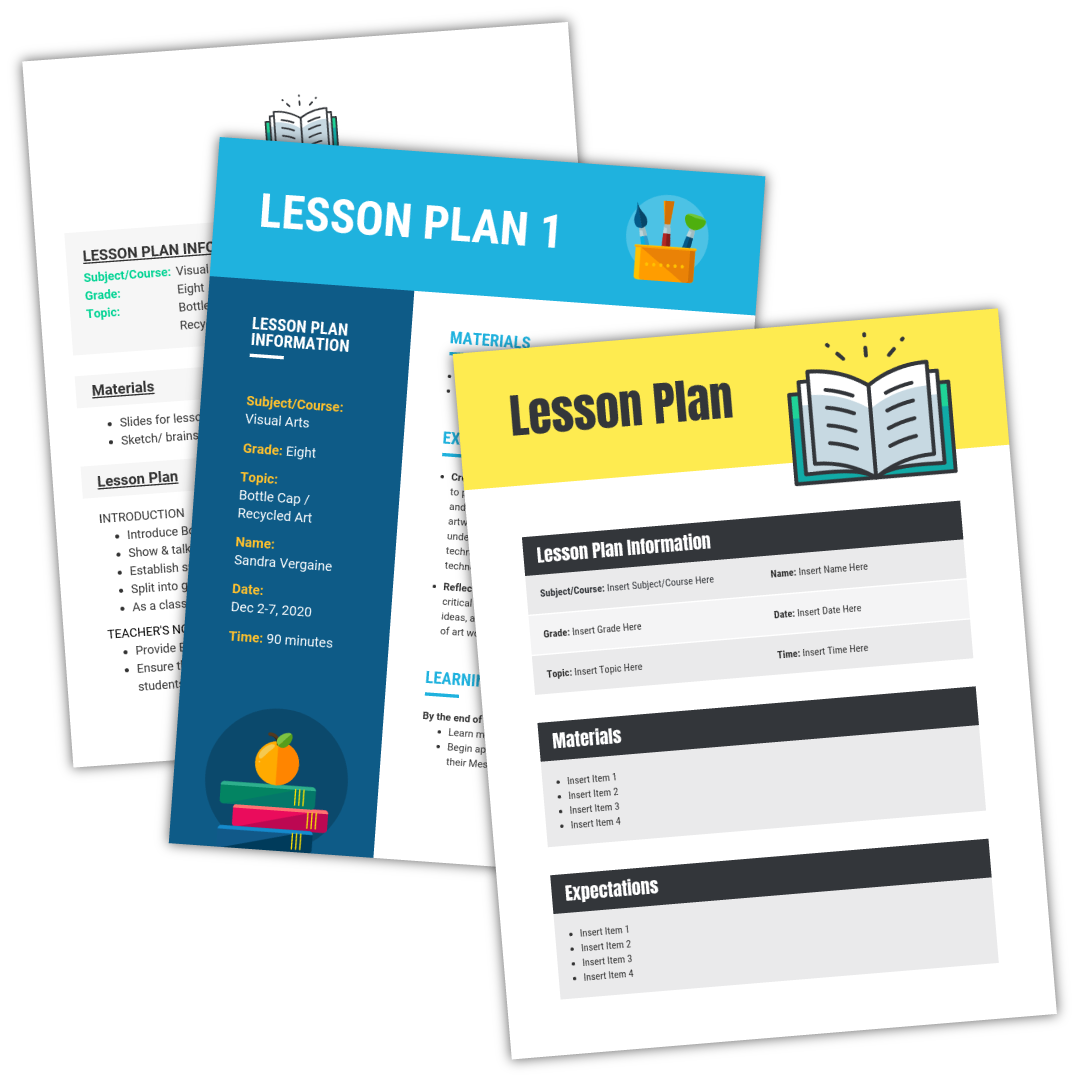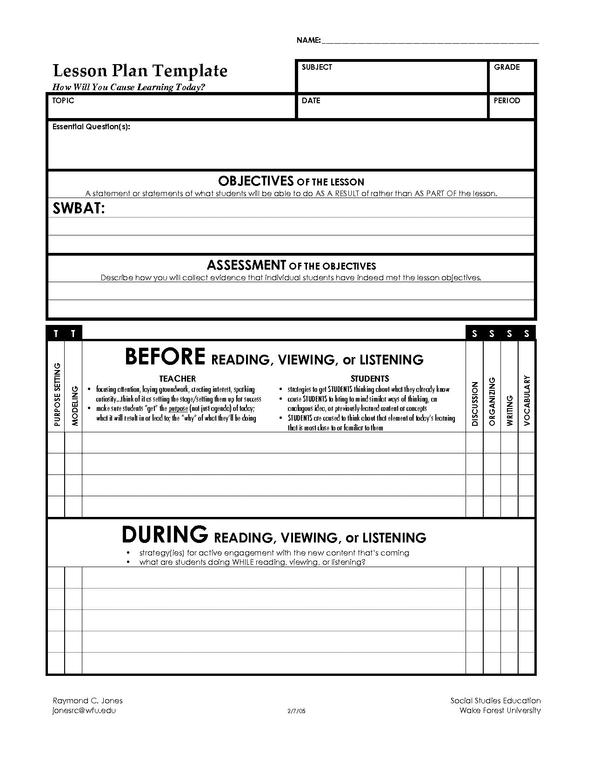Top 5 Easiest Guides And Useful Tips For Creating A Simple Lesson Plan Template 2021
How Do You Write A Simple Lesson Plan?
A lesson plan prepares you for class by offering a clear overview for the day, regardless of the material or subject you're teaching. Your lesson plans don't have to be complicated or long; they just need to include information on what you're teaching, how you'll teach it, and what goals and objectives you want your students to achieve as part of the curriculum.
Each class you teach should build on the prior session and flow easily into the next, regardless of the components inside a lesson plan. Of course, knowing what goes into developing a lesson plan makes it easier to create one that flows from class to class!
After you've selected the elements that must be included in teaching your class, follow these eight stages to create your lesson plan:
Determine The Objectives
To create a lesson, you must first determine the goals of each class. By the conclusion of the term, what do you aim to have accomplished? Are there any special skills or knowledge that your pupils should possess? After reading a chapter on animals in Brazil, a lesson aimed at younger kids would be to be able to recognize creatures that reside in the jungle. This aim may include learning how to solve algebraic problems for older children.
Determine Your Students' Needs
Are you introducing new content or reviewing what you've already taught in a previous session with this lesson? Make sure students know what to expect at the outset of class so they can stay focused on reaching your goals. Some of your students may require more encouragement than others when studying topics. It will be easier for you to prepare if you identify these needs in your lesson plan.
Compile A List Of Your Resources And Materials
Make a list of the items and resources you'll need to teach this lesson, including paper, pens, and rulers. When applicable, add technology resources such as laptops and gamified learning tools such as applications or instructional websites in your plan.
Encourage Your Students To Participate
What good is a lesson if your students aren't interested? You want them to care about what you're teaching them. As a result, in order to prepare, you must pique their interest in the topic of the class. Give them a rundown of what you'll be talking about. Then, more casually, introduce the matter. If you're teaching pupils a formula, for example, consider deriving it from scratch to help them understand where it comes from. Alternatively, if you're talking about historical events, try to make connections between them and contemporary events so that students can relate to the subject.
Provide Instruction And Information
It's time to give the knowledge to your students after you've set the stage for what you'll be teaching. Now is the moment to teach and make use of the resources you've included in your lesson plan. When feasible, involve your pupils in the process to keep them engaged. You may, for example, ask students to come to the board and solve problems or respond to questions.
It's all about presenting knowledge and concepts in a meaningful way, whether it's reading from a book, utilizing props like blocks for younger children, or displaying graphics on the screen for older students. Remember to take into account your pupils' various learning styles so that you can use teaching approaches that work for everyone.
Carve Out Time For Students To Practice
Allow time for students to practice new content after it has been taught. There are three practice approaches that, when used in the correct order, might help to reinforce what you've recently taught:
Guided practice – With guided practice, you walk students through what they've just learned, allowing them to add their own comments as they acquire confidence with the new material.
Process of collaboration — The collaborative approach is all about students talking with their classmates as they explore these new concepts, whether in pairs or in groups. Circulate throughout the class, providing additional teaching or assistance as needed to explain topics.
Independent practice – Following the collaborative practice, students should practice what they've learned on their own. Use worksheets or have students compose a short essay to adapt independent practice to the subject you've just delivered.
Ending The Lesson
Bring the class to a close with a quick wrap-up. Make a quick summary of the lesson, including the important concepts that the students learnt. As a reminder, have students identify the essential themes, and give them a previewof the following session so they know what to expect.
Examine The Lesson
Did you accomplish your learning goals? Use a quick quiz or test to allow pupils to demonstrate that they understand the content. Your next lesson plan may contain a review of information before moving on to new material, depending on the outcomes.
What Are The 5 Parts Of The Lesson Plan?
Objectives
Write out what you anticipate your pupils to be able to accomplish by the end of the lesson, for example, "pronounce, identify, put words in sentences, change into passive, compare, answer, use, match,....etc" or any other verbs that may be observed and measured in the classroom.
Warm-up
Revisit the previous lesson, check homework orally, correct common errors, and so on, or any other activity that can energise pupils and ready them to receive new material.
Presentation
Present the new material using appropriate strategies, and write down the procedures you'll use to explain it.
Practice
It is the pupils' work, whether it is managed, guided, or unguided. Students complete certain exercises depending on the information provided. This type of activity is frequently found in the set book.
Assessment
Write some sentences on the board or pass out printed papers to determine if the objectives were met and if students learned what they were supposed to learn. If this is the case, you should re-teach the topic using other methods.
What Is A Lesson Plan And Example?
A lesson plan is a document that steps you through the topic of your class. It's a list of tasks that your pupils will complete to assist you in planning your lessons.
A lesson plan is typically planned ahead of time and can include a single activity, a full lesson, a unit or course, a day, or a week.
Lesson plans are primarily printed or saved as PDF documents for a teacher to follow. You have the option of designing your own lesson plan layout or using a pre-made lesson plan template.
What Is A Lesson Plan Outline?
There are numerous sorts of lesson plan samples available to assist you in organizing your class materials. It can take a whole day, a week, a month, or even an entire course to create a lesson planner for a single session to utilize for a one-off activity for a small group. Fortunately, blank lesson plan templates can assist!
A lesson plan can be classified as detailed, semi-detailed, or understanding by design (UbD) using the following criteria:
Detailed: A complete plan contains what you'll teach, as well as the teacher planner and student activities.
Semi-detailed: A semi-detailed plan is simpler and provides a rough outline of what you intend to cover on a given day or class.
Understanding by design (UbD) is a reversed engineering approach that focuses on analyzing results before developing curriculum modules for students. In general, the following are the most popular types of lesson plans:
Type 1: Lesson Plan (Daily, Weekly, Or Monthly)
A daily, weekly, or monthly lesson plan lays out all of the activities and topics you'll be covering until the end of the day, week, or month. The lesson plan prepares students for the next class and outlines any assessments that need to be performed, such as exercises, chapter examinations, projects, and so on, at the end of each class.
This type of lesson plan can help you stay on track with your teaching schedule, adhere to state standards, and is useful for remote learning. This form of lesson plan is classified as a detailed lesson plan.
Type 2: Unit Lesson Plan
A unit lesson plan is another technique to plan your education. When you plan a unit, you write down all of the instructional goals as well as a predicted completion date. Each unit provides specific activities and learning experiences utilizing a variety of learning styles to provide a systematic manner of subject matter training (e.g., social studies, physical science, and so on).
Although unit lesson plans tend to follow a systematic manner, what is addressed each day is rather flexible. As a result, it belongs to the semi-detailed lesson plan category.
Type 3: Lesson Plan By Topic Or Subject
A thorough lesson plan is a lesson plan that is designed around a certain topic or subject. It can be utilized to provide extensive understanding in a certain academic subject or professional niche, whether it be Science, Maths, English, Music, Art, or any other expertise.
Type 4: E-Learning Lesson Plan
An e-learning lesson plan provides a structure that is split down into smaller portions, allowing students to better understand the content delivered. It might be either fully detailed or partially detailed.
However, because online lessons lack the immediacy of classroom instruction, a teacher must undertake a lot of work to transmit this information. Using a variety of interactive media in your activities, such as images, video, and audio, can help students get the most out of the lesson and stay interested at all times.
As you can see, each lesson plan is unique, and as a teacher, you'll need to try out several forms to see what works best for you and your teaching style. You should also consider the learning curriculum while you're at it. This must be appropriate for the grade level you are teaching, as well as the geographical criteria established by the country in which you teach.
If you are a K-12 teacher (elementary to high school) in the United States, for example, you must guarantee that your instructional materials match the Common Core* criteria.
What Is 4 A's Lesson Plan?
The importance of lesson plans in education cannot be overstated. They're a written plan that outlines what a teacher will accomplish during the school day, week, and year to attain the goals. Lesson plans usually have a structure that includes goals and objectives, teaching methods, and assessment. These fundamental elements can be tweaked in a variety of ways to meet the needs of individual students and teachers.
The four primary principles are the focus of the 4-A lesson plan methodology. Each is crucial for student achievement, and teachers may ensure that they are front-and-center by determining how they will be employed in instructional methods. The four elements are as follows:
Prior knowledge should be activated
Learn something new
Application
Assessment
Teachers can use these broad categories, which we'll break down a little later, to ensure that kids are ready to learn. Students create essential connections to previous learning and prepare their brains for new topics by activating former knowledge. New knowledge is provided and taught before being applied to real-world or previous scenarios. Finally, a test is administered to establish whether or not the students have grasped the material. Let's take a closer look at these elements.





